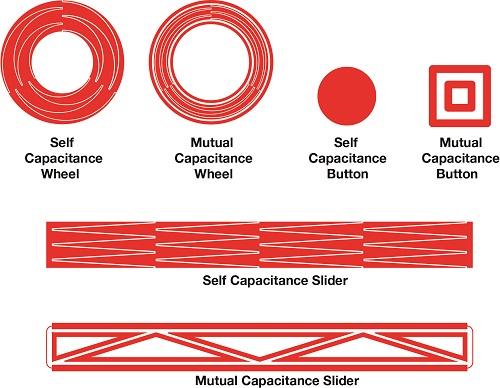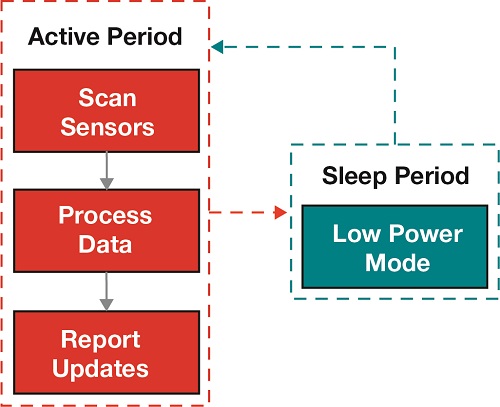BY YIDING LUO, System Applications Engineer
Texas Instruments Inc.
www.ti.com
The IoT continues to influence and modernize products for home and building automation. Although this market is expected to grow significantly, its potential depends on how users adopt these products, so manufacturers are focusing on designing their products with more elegant user interfaces to entice more users.
Human-machine interface (HMI) is a common feature present in almost every electronic system for products like smart home controls, security access panels, appliances, and audio devices. HMI is an intuitive and interactive subsystem that can truly differentiate a product by enhancing the user experience and thus captivate user attention. Integrating capacitive touch sensing is a new way to improve HMI features and stay competitive in the marketplace.
The capacitive touch-sensing technology helps create more elegant touch interfaces compared to traditional mechanical buttons. However, the operating environment, system complexity, design flexibility, and power consumption are putting pressure on product designers. This article explains how to enable elegant HMI designs while it elaborates critical challenges as well as system solutions related to capacitive touch-sensing technology.
Touch operating environment
A reliable product should have a user interface that works in all anticipated environments. Sometimes capacitive touch sensors and controllers can be significantly affected by harsh environments, extreme temperatures, humidity, and moisture buildup.
Mechanical buttons use physical movement to trigger a touch event, but capacitive touch is fundamentally different because it detects changes in the sensors’ electric field and capacitance over time. This operating principle makes the capacitive touch more vulnerable to moisture influence. For outdoor and kitchen applications, moisture tolerance is critical because these products are expected to work around the presence of water.
To handle processor temperature and humidity drifting, your system needs to be able to track the capacitive touch sensors’ baseline of the surrounding environment. It can be achieved by using a software algorithm, which calculates the long-term average, and a filtering mechanism for the reference value. This, in turn, ensures that the capacitive touch interface provides a consistent user experience.
A 12-button keypad capacitive touch design is a case in point; it passes full touch function testing under the IPX5 water ingress test condition. This design uses a mutual capacitance measurement topology with an actively driven shield to limit crosstalk between sensors, thus minimizing the ground-coupling effect. In addition to the sensor design, moisture-tolerance firmware running on the microcontroller (MCU) also helps increase reliability.
Touch-sensing interface design
The hardware and software development of a capacitive touch-sensing interface design can be more complex than a design with conventional mechanical buttons. For hardware, you need to consider printed circuit board (PCB) routing with sensors electrode layout as well as the mechanical structure. For software, additional firmware is necessary to scan the sensors and process measurement data.
To help shorten time-to-market, chip suppliers are providing tools to accelerate the design and prototype process. TI, for instance, offers a capacitive touch-sensing design guide that helps address the system-level challenges and presents solutions as well as best practices for manufacturability. The chip vendor has also developed a design tool that can generate the firmware code based on your system configuration. Fig. 1: The key building blocks of the capacitive touch-sensing design value chain.
Fig. 1: The key building blocks of the capacitive touch-sensing design value chain.
Industrial designs are becoming an important factor in the success of IoT products, especially in the smart home and consumer electronics markets, and switching from mechanical buttons to capacitive touch allows product designers to deliver more innovative industrial designs. The winner is evident if consumers have to choose between a bulky door lock with a mechanical button keypad and a modern smart door lock with a sleek capacitive touch panel keypad and LED backlighting.
The capacitive touch sensors can be designed in a variety of shapes, sizes, configurations, and materials to suit various product enclosures and different interface functions. Their flexibility also simplifies mechanical assembly and eliminates moving parts, ultimately reducing the manufacturing cost. However, just having innovative ideas is not enough; you will also need a flexible controller — a.k.a. MCU — to help unlock all of the design possibilities. Fig. 2 shows some sensor layout examples.
 Fig. 2: Sensor layout examples in a capacitive touch design.
Fig. 2: Sensor layout examples in a capacitive touch design.
Power consumption
Ultra-low power is a critical requirement for a touch interface solution in battery-operated smart home products and consumer electronics devices such as electronic door locks, wireless light controllers, and Bluetooth headphones.
Unlike conventional mechanical buttons, which keep the system asleep until the detection of a touch event, a capacitive touch controller needs to periodically wake up to scan the sensors in order to detect user interactions that represent touch events. Fig. 3 shows the typical process flow of a capacitive touch controller.
 Fig. 3: View of a typical touch controller scan flow.
Fig. 3: View of a typical touch controller scan flow.
To achieve low power consumption, you can optimize the scan rate, which is how frequently the controller wakes up to scan the sensors. The lower the scan rate, the lower the power consumption — but with the trade-off of response time. The typical scan rate for a capacitive touch interface in consumer electronics is in the range of 8 Hz to 100 Hz.
The active period power consumption is a critical contributor to overall power consumption. There are many capacitive touch solutions in the market, but most controllers need the main processor in the active period to scan the sensors and process the measurement data. This approach inevitably results in higher system power consumption. For example, you may turn your Bluetooth speaker on and off and adjust the volume 10 times a day. But even when you are not interacting with the product, the main processor still has to be active and process the sensor data.
However, low power is such an essential requirement, so some IC manufacturers are now incorporating digital state machine in their capacitive touch controllers for scanning the sensor and processing measurement data during active periods. With this approach, the main processor, which consumes most of the power, doesn’t need to wake up at all until the detection of a touch event.
So if power consumption is what is holding you back from switching to capacitive touch, make sure you choose an MCU that implements the state machine-based automated scanning technique.
Conclusion
As the user experience becomes more critical in modern product designs, capacitive touch sensing is increasingly becoming a popular technology for designing creative, sophisticated, and cost-effective user interfaces. Subsequently, the demand for robust capacitive touch controllers is motivating chipmakers to continue innovating their IC solutions and help address system challenges like power consumption, design flexibility, system complexity, and resistance from environmental influences.
Editor’s Note: This is the second article in a series about HMI design. The first article, titled “What you should keep in mind when designing HMI for factory automation,” was published in the February 2018 issue of Electronic Products.
Advertisement
Learn more about Texas Instruments





